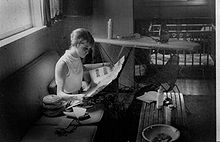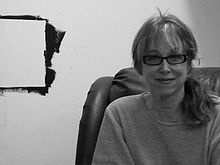- Ming C. Lowe
-
Ming C. Lowe (born October 13, 1945) is an American painter of large scale contemporary works on canvas and a fine art photographer. She emerged from the most embryonic ’60s rock ‘n’ roll scenes to become a unique voice in the Southern California desert, where her home was a gathering place for like-minded, creatively-driven individuals of all genres of the arts seeking a place of peace and inspiration amid the turbulence of what was called the counter-culture.
After her work attracted and served as a source of inspiration for the likes of Eric Burdon of the Animals, Paul Butterfield, Sterling Morrison of the Velvet Underground, American Indian guitar legend Jesse Ed Davis and James Gurley of Big Brother and the Holding Company, Ming moved from Palm Desert to the nearby Santa Rosa Mountains and began producing photographic art inspired by visits to working and abandoned Midwest steel mills; the living, breathing waterfronts of San Diego; the juke joints of the Mississippi Delta, and images of the 9/11 in catastrophes in New York and Washington, D.C..
The significance and vitality of her art is growing in national recognition as the underground she once nurtured becomes more mainstream. Today, her work can be seen in the catalogs of Fortune 500 business and national museums and art galleries.
Contents
Biography
Ming was born in Washington, D.C.. Her mother, Choral Lowe, named her Ming after her attraction to Ming Dynasty art. It may have seemed a strange, non-conformist act in 1945 mainstream America, but Ming considered it her mother's greatest gift.
Ming's grandfather, a successful businessman, owned homes in Salt Lake City, Utah, and the beach town of La Jolla, California Ming grew up in both cities, excelling in swimming and tennis. But she was largely ignored by her parents. There was never a breakfast before school. No money for lunch. No toys. No movies. No hugs. No "I love yous." A different school every year. Ming tested with an I.Q. of 143 and showed early signs of artistic talent. But she was not encouraged to pursue any of her passions. Her parents divorced when she was 12, launching Ming on a journey of boarding schools and public schools from Arcadia, California to Las Vegas to Salt Lake as her mom remarried, divorced and remarried again. Left alone with her grandparents in Salt Lake, Ming easily passed the University of Utah's college boards exams, but dropped out of the 11th grade when her grandparents went to Europe. Ming then headed west to California. She wanted to be a beatnik. She had her own car and a pack of unfiltered Camel cigarettes.
Birth of a counter-culture
Ming returned to La Jolla in 1961 as a shy 15½-year-old red head with a passion for more cerebral jazz, folk and blues. She met a group of guys from Windansea Beach and joined them in the youth culture they created around surfing and beer bashes.[1] With her fake ID, she rented a studio apartment in Pacific Beach and paid the rent with a $100 child support check from her father. She supplemented her income working at the first Hobie Surfboard Shop in San Diego County for Chuck Hasley, a former school teacher who would lead the Windansea team to victories in surf competitions.[2] Ming, who answered their fan mail, also participated in the surfer group, the Mac Meda Destruction Company.[3] She got pregnant just before the city discovered she was a 17-year-old truant. She moved to Palm Desert, where her mother and stepfather were publishing Desert Magazine. Her mother signed her marriage license and gave them a $100 gift. They divorced in 1966 after having two daughters, Sloane and Portia Perry. Ming retained her married name, Ming Perry, and remained a part of the La Jolla scene while raising her daughters as a single parent. Tom Wolfe spent a summer in La Jolla and skimmed the surface of its "underground society" in his 1965 book, "The Pump House Gang." Ming was more integral to the real scene, helping her friend, Anchovie Barca, turn the Hippodrome ice skating rink into the Fillmore West of San Diego. She had a party with a blues band playing in her living room and police raided it for disturbing the peace. Twenty-one of Ming's friends were arrested after police reported finding marijuana and peyote in the house of "Mrs. Ming Perry, a 21-year-old divorcee and mother of two children", according to the San Diego Union.[4] Ming recalled hearing herself called "the Dragon Lady" on radio. The counter-culture became prominent across the U.S. in 1966. Ming was visiting a friend on the Sunset Strip when the riot broke out that inspired Stephen Stills to write "For What It's Worth." She was invited in 1967 to the Monterey Pop Festival by Cass Elliott of the Mamas and the Papas, whose boyfriend was a surfer from Windansea. She was in the front row at the Altamont Festival when the West Coast scene came to a violent end during a set by the Rolling Stones. Other prominent figures from the 1960s, including comedian Jonathan Winters, English rocker Eric Burdon, Velvet Underground guitarist Sterling Morrison, Native American guitarist Jesse Ed Davis, blues legend Taj Mahal, and actors Brad Douriff from "One Flew Over the Cuckoo's Nest" and Teddie Markland from "Wanda Nevada", began showing up at her back door after Ming bought a house in Palm Desert in 1967. The now posh destination was still part of the desert frontier when Ming built her own studio there. When Palm Springs had its own rock festival in 1969, about 60 friends slept on the floor and roof of Ming's house. Burdon called it "a great meeting place for artists and travelers attracted to the desert."[5]
The art
Ming was a self-taught artist. An experience she had at a friend's art class at age 8 influenced her to pursue art. Perhaps because of her parents’ deprecations, Ming did not consider herself a real artist. Then, at age 29, she had her first one woman show at a gallery in Palm Desert. People who saw her work began giving her commissions, one of which resulted in a large scale portrait of a Masai warrior. Her portraits, ranging from jazz and rock subjects to the Utah execution of Gary Gilmore, often revealed a punk boldness and strength. She had her first show of paintings in 1978 in Long Beach, California, followed by many Palm Springs-area exhibitions. Her international collectors included many of her famous friends.[6] But Ming always sought to duplicate the feel of that childhood art class. There was an energy in that large, empty room with one big painting on a large easel. She built her own gallery on her Palm Desert property in the mid-1980s and captured that energy by placing her large paintings on big canvases in open rooms. Her gallery also served the community with free screenings of surreal films by Luis Buñuel, attracting the likes of avant garde composer Ernst Krenek and underground filmmaker Kenneth Anger. Soon, Ming was recognized as a vital artist by reviewers[7] and a unique personality by a newspaper columnist who covered Palm Springs celebrities.[8] When she needed more space and privacy than Palm Desert could afford, Ming moved to the mountain community of Pinyon and used her self-taught architectural and construction skills to design and build a multi-dimensional house and furniture to give her home the energy her art demanded. With her art now properly housed, Ming gained the confidence to travel and experiment in photography. She was in the top floor of the Hotel Washington across from the White House when a terrorist-piloted jet crashed into the Pentagon on 9/11. She was photographing the smoke from the crash when President Bush's helicopter emerged from the smoke to land on the White House lawn, giving Ming a powerful image. Recognizing the history of the moment, Ming got into the restricted areas of Ground Zero in New York to capture the breadth of the national disaster. She then juxtaposed the photos with images of Muslim culture taken from her international travels for a compelling show that somehow found a universalism in all the lines and angles titled "Here and there. 911."
Fascinated by the geometric spirituality of her images, Ming began a cross-country tour of steel mills and industrial Americana after designing her own custom motor home. Many of the anthropological-yet-ballet-like images she photographed were pledged to U.S. Steel in Gary, Ind. Before Ming could do any more with these pieces, she was commissioned in 2006 to photograph the San Diego waterfront for the Port Authority's Art in Public Places program. The year-long project resulted in a 30-photograph essay, "Shift Change: The Working Waterfront", which opened at the Balboa Photography Museum. It has been shown at museums throughout San Diego County.
Samplings of shows
"Mississippi Blacktop," photo essay of historic Delta culture, Artspresso Gallery, Idyllwild, Calif., 2007–2008
"Shift Change: The Working Waterfront," photo essay, Maritime Museum, San Diego; Balboa Photography Museum, San Diego; National City Library, National City, California; Coronado Museum of History and Art; San Diego International Airport, 2006–2007
"Here and there. 911," photo essay, Peppertree Bookstore, Palm Springs; Artspresso Gallery, Idyllwild, California, 2004
"El Dia De Los Muertos," group show, paintings, Del Rios Gallery, Palm Desert
Notable photographic portraits, including Eric Burdon, James Gurley, Daniel Lanois, Johnette Napolitano, Eagles of Death Metal, Johnny Rivers, Noah Purifoy, Bob Seidemann, Kurt Shaw, Victoria Williams, Ted Quinn, presented in The Desert Sun newspaper, Palm Springs; the Hi-Desert Star, Yucca Valley, California; Pappy & Harriet's Pioneertown Palace, Pioneertown, California, the Noah Purifoy Foundation, Joshua Tree, California, among others, 2004
"Real Fantasy and Fantastic Reality," industrial photography, Artspresso Gallery, 2002
"25 Year Retrospective," one-woman show, paintings, Cathedral City Library, Cathedral City, California, 2000
Six New Paintings, one-woman show inspired by Jamaican travels, Ming C. Lowe Gallery, Palm Desert, California, 1986–87
One Woman Show: Paintings, Kimball Art Center, Park City, Utah, 1982–83
References
- ^ Gault-Williams, Malcolm. "Legendary Surfers." Dec. 16, 2006: http://legendarysurfers.com/blog/2006_12_01_archive.html
- ^ Rodgers, Terry. "Chuck Hasley - founder of Windansea Surf Club." Extreme Forum: March 29, 2005
- ^ Jack MacPherson. Wikipedia. https://secure.wikimedia.org/wikipedia/en/wiki/Jack_Macpherson
- ^ "La Jolla ‘Pot’ Party Raided; 21 Held", Aug. 2, 1967. San Diego Union
- ^ Burdon, Eric. "Don’t Let Me Be Misunderstood." New York: Thunder's Mouth Press, 2001. Pg 88
- ^ Killian, Austin. "Ming Lowe works reflect era of war." The Desert Sun. Palm Springs: Oct. 13, 1984
- ^ Stark, Les. "Lowe's ‘New Work’ opens at studio gallery." Los Angeles Times. Los Angeles. June 11, 1988; Klifman, Mary. "Six New Paintings." The Desert Sun, Feb. 7, 1987
- ^ Fessier, Bruce. "Aesthetics of Tragedy." The Desert Sun. September 2, 2004
External links
Categories:- 1945 births
- Living people
- American painters
- American photographers
- Contemporary painters
- Women painters
Wikimedia Foundation. 2010.


